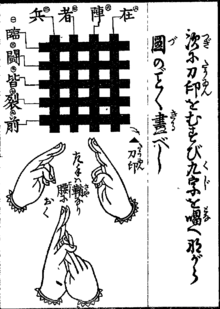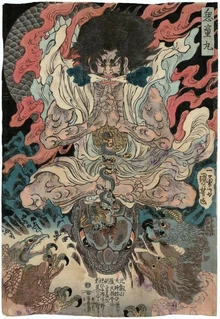
Kuji-Kiri (九字切り - Kujigiri lit. "nine symbolic cuts") is a practice of using hand gestures found today in Shugendō and Shingon Mikkyō. It is also present in some old and traditional schools ("ryūha") of Japanese martial arts including but not exclusive to schools that have ties with ninjutsu.
Overview[]
Kuji-in is the spiritual and mental strength the ninja possessed in the form of hand signs. These hand signs were believed to be able to channel energy. The hand signs were taken from the practices of the early Buddhists. Kuji-in was used to build confidence and strength in the ninja. It was also believed to enhance the senses of danger and foresee death for the ninja. In Kuji-in the thumb represents the source of power (Ku), and the fingers represent the four elemental manifestations. They are Chi (earth - solids), Sui (water - liquids), Ka (fire - combustion) and Fu (wind - gases). There are 81 hand symbols, total, but there are 9 primary ones: Rin, Hei, Toh, Sha, Kai, Jin, Retsu, Zai, and Zen.
Each symbol invokes different strengths and abilities in a trained ninja. Rin brings strength to the mind and body; Hei generates psychic power in order to mask one's presence; Toh enables the ninja to reach a balance between the solid and liquid states of the body, which leads to a greater harmony with the universe; Sha is used to heal oneself or another; Kai gives complete control over the body's functions, enabling one to slow the heart rate, endure extreme heat and cold, etc. Jin increases the mind's telepathic powers, giving a highly trained Ninja the ability to read the character of another; Retsu gives telekinetic powers, enabling a ninja to stun an opponent with a shout or touch. Zai extends the harmony gained by merging with the universe. Zen brings enlightenment and understanding. These symbols take an entire lifetime to truly master.
Mystical Properties[]
It was believed that the practice of Kuji-Kiri yielded the user superhuman attributes in certain applications as an esoteric practice which, when performed with an array of hand "seals" (kuji-in), was meant to allow the ninja to enact superhuman feats. The kuji ("nine characters") is a concept originating from Taoism, where it was a string of nine words used in charms and incantations. In China, this tradition mixed with Buddhist beliefs, assigning each of the nine words to a Buddhist deity.

The kuji may have arrived in Japan via Buddhism, where it flourished within Shugendō. Here too, each word in the kuji was associated with Buddhist deities, animals from Taoist mythology, and later, Shinto kami. The mudrā, a series of hand symbols representing different Buddhas, was applied to the kuji by Buddhists, possibly through the esoteric Mikkyō teachings. The yamabushi ascetics of Shugendō adopted this practice, using the hand gestures in spiritual, healing, and exorcism rituals. Later, the use of kuji passed onto certain bujutsu (martial arts) and ninjutsu schools, where it was said to have many purposes. The application of kuji to produce a desired effect was called "cutting" (kiri) the kuji. Intended effects range from physical and mental concentration, to more incredible claims about rendering an opponent immobile, or even the casting of magical spells. These legends were captured in popular culture, which interpreted the kuji-kiri as a precursor to magical acts.